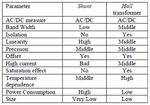San_Pandey
Newbie level 4

Hello everyone,
I have a doubt regarding current sensing method.
Why can't we measure current using small resistance all the time? Why to buy hall sensors for that? Is there any concept behind that which I am not aware of ?
I have a doubt regarding current sensing method.
Why can't we measure current using small resistance all the time? Why to buy hall sensors for that? Is there any concept behind that which I am not aware of ?




